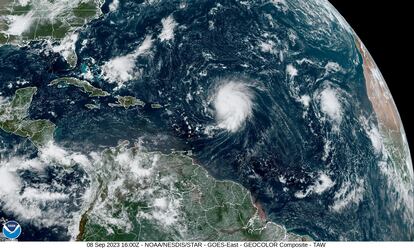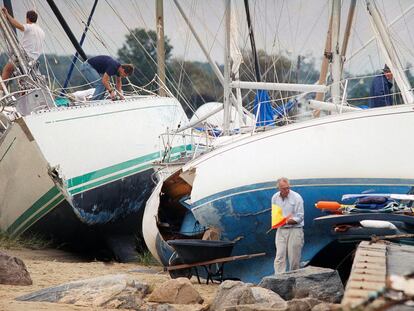Enormous storm Lee lashes New England and Canada with wind, heavy rain, pounding surf
The storm skirted some of the most waterlogged areas of Massachusetts that experienced severe flash flooding days earlier

Storm Lee toppled trees and cut power to tens of thousands Saturday as it lashed New England and eastern Canada, threatening hurricane-force winds, dangerous storm surge and torrential rains across an enormous swath even though its center had yet to come ashore.
The storm, still dangerous after being downgraded from hurricane to post-tropical cyclone, was expected to make landfall at or just below hurricane strength around the Maine-New Brunswick border Saturday afternoon, then turn to the northeast and move across Atlantic Canada on Saturday night and Sunday.
The storm skirted some of the most waterlogged areas of Massachusetts that experienced severe flash flooding days earlier, when fast water washed out roads, caused sinkholes, damaged homes and flooded vehicles.
But the entire region has experienced an especially wet summer — it ranked second in the number of rainy days in Portland, Maine — and Lee’s high winds toppled trees stressed by the rain-soaked ground in Maine, the nation’s most heavily wooded state.
“We have a long way to go, and we’re already seeing downed trees and power outages,” said Todd Foisy, a National Weather Service meteorologist.
The storm’s center was just off the southwestern tip of Nova Scotia, about 105 miles (170 kilometers) southeast of Eastport, Maine, and about 150 miles (240 kilometers) southwest of Halifax, Nova Scotia, the U.S. National Hurricane Center said at 11 a.m. EDT Saturday. It had maximum sustained winds of 75 mph (120 kph) and was moving north at a fast clip of about 22 mph (35 kph).
The National Hurricane Center downgraded Hurricane Lee to a post-tropical cyclone but millions of people remained under storm watches and warnings early Saturday as the storm still could produce hurricane-force winds, torrential rain and coastal flooding.
Severe conditions were predicted as a possibility across portions of Massachusetts and Maine and hurricane conditions could hit the Canadian provinces of New Brunswick and Nova Scotia, where the storm had been predicted to make landfall later Saturday.
The storm was located about 230 miles (365 kilometers) southwest of Halifax, Nova Scotia, and about 220 miles (355 kilometers) southeast of Eastport, Maine on Saturday morning.
There were more than 11,000 power outages from Massachusetts to Maine early Saturday. The wind had picked up and rain moved into eastern Massachusetts.
The hurricane center predicted hurricane-force winds extending more than 100 miles (161 kilometers) from Lee’s center with lesser but still dangerous tropical storm-force gusts up to 345 miles (555 kilometers) miles outward.
States of emergency were declared for Massachusetts and Maine, the nation’s most heavily forested state, where the ground was saturated and trees were weakened by heavy summer rains.
Cruise ships found refuge at berths in Portland, while lobstermen in Bar Harbor, Maine, and elsewhere pulled their costly traps from the water and hauled their boats inland, leaving some harbors looking like ghost towns on Friday.
Lee already lashed the U.S. Virgin Islands, the Bahamas and Bermuda before turning northward and heavy swells were likely to cause “life-threatening surf and rip current conditions” in the U.S. and Canada, according to the hurricane center.
Parts of coastal Maine could see waves up to 15 feet (4.5 meters) high crashing down, causing erosion and damage, and the strong gusts will cause power outages, said Louise Fode, a National Weather Service meteorologist in Maine. As much as 5 inches (12 centimeters) of rain was forecast for eastern Maine, where a flash flood watch was in effect.
But even as they hunkered down and prepared, New Englanders seemed unconcerned by the possibility of violent weather.
In Maine, where people are accustomed to damaging winter nor’easters, some brushed aside the coming Lee as something akin to those storms only without the snow.
“There’s going to be huge white rollers coming in on top of 50- to 60-mph winds. It’ll be quite entertaining,” Bar Harbor lobsterman Bruce Young said Friday. Still, he had his boat moved to the local airport, saying it’s better to be safe than sorry.
On Long Island, commercial lobsterman Steve Train finished hauling 200 traps out of the water on Friday. Train, who is also a firefighter, was going to wait out the storm on the island in Casco Bay.
He was not concerned about staying there in the storm. “Not one bit,” he said.
In Canada, Ian Hubbard, a meteorologist for Environment and Climate Change Canada and the Canadian Hurricane Centre, said Lee won’t be anywhere near the severity of the remnants of Hurricane Fiona, which washed houses into the ocean, knocked out power to most of two provinces and swept a woman into the sea a year ago.
But it was still a dangerous storm. Kyle Leavitt, director of the New Brunswick Emergency Management Organization, urged residents to stay home, saying, “Nothing good can come from checking out the big waves and how strong the wind truly is.”
Destructive hurricanes are relatively rare this far to the north. The Great New England Hurricane of 1938 brought gusts as high as 186 mph (300 kph) and sustained winds of 121 mph (195 kph) at Massachusetts’ Blue Hill Observatory. But there have been no storms that powerful in recent years.
The region learned the hard way with Hurricane Irene in 2011 that damage isn’t always confined to the coast. Downgraded to a tropical storm, Irene still caused more than $800 million in damage in Vermont.
Sign up for our weekly newsletter to get more English-language news coverage from EL PAÍS USA Edition
Tu suscripción se está usando en otro dispositivo
¿Quieres añadir otro usuario a tu suscripción?
Si continúas leyendo en este dispositivo, no se podrá leer en el otro.
FlechaTu suscripción se está usando en otro dispositivo y solo puedes acceder a EL PAÍS desde un dispositivo a la vez.
Si quieres compartir tu cuenta, cambia tu suscripción a la modalidad Premium, así podrás añadir otro usuario. Cada uno accederá con su propia cuenta de email, lo que os permitirá personalizar vuestra experiencia en EL PAÍS.
¿Tienes una suscripción de empresa? Accede aquí para contratar más cuentas.
En el caso de no saber quién está usando tu cuenta, te recomendamos cambiar tu contraseña aquí.
Si decides continuar compartiendo tu cuenta, este mensaje se mostrará en tu dispositivo y en el de la otra persona que está usando tu cuenta de forma indefinida, afectando a tu experiencia de lectura. Puedes consultar aquí los términos y condiciones de la suscripción digital.
More information
Archived In
Últimas noticias
Most viewed
- Reinhard Genzel, Nobel laureate in physics: ‘One-minute videos will never give you the truth’
- Oona Chaplin: ‘I told James Cameron that I was living in a treehouse and starting a permaculture project with a friend’
- Pablo Escobar’s hippos: A serious environmental problem, 40 years on
- Chevy Chase, the beloved comedian who was a monster off camera: ‘Not everyone hated him, just the people who’ve worked with him’
- Why we lost the habit of sleeping in two segments and how that changed our sense of time










































